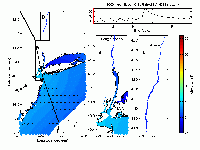Flood Modeling
A unique aspect of the Hudson River Flood Impact Decision Support System version 1 is that it is based on “dynamic” water flow modeling that combines tides, storm surges, sea level rise, and tributary freshwater inputs to the Hudson. The flood zones for 5-year to 1000-year storm events are created using statistical analysis of data for a set of 881 storms – which includes all of the various types of storms that could strike the region. The dynamic model is the same one that is used for the New York Harbor Observing and Prediction System (NYHOPS; http://stevens.edu/nyhops).
The dynamic flood modeling, developed by the Stevens Institute of Technology, includes both historical events and synthetic events. The latter are realistic tide/storm/rain combinations that have not occurred in the limited historical record. Including these synthetic events within the computer modeling provides an improved estimation of low-probability flood events such as the 100-year (1% annual chance) or 1000-year (0.1% annual chance) flood.
Below are sample animations of historical flood events and synthetic events used in developing the Hudson River Flood Impact Decision Support System. For more information, see our Technical Report.

 Albany, NY: 24in. Sea Level Rise, 50yr. Storm Return
Albany, NY: 24in. Sea Level Rise, 50yr. Storm Return Albany, NY: 24in. Sea Level Rise, 20yr. Storm Return
Albany, NY: 24in. Sea Level Rise, 20yr. Storm Return Albany, NY: 24in. Sea Level Rise, 10yr. Storm Return
Albany, NY: 24in. Sea Level Rise, 10yr. Storm Return Albany, NY: 24in. Sea Level Rise, 5yr. Storm Return
Albany, NY: 24in. Sea Level Rise, 5yr. Storm Return Albany, NY: 0in. Sea Level Rise, 1000yr. Storm Return
Albany, NY: 0in. Sea Level Rise, 1000yr. Storm Return Albany, NY: 0in. Sea Level Rise, 200yr. Storm Return
Albany, NY: 0in. Sea Level Rise, 200yr. Storm Return Albany, NY: 0in. Sea Level Rise, 100yr. Storm Return
Albany, NY: 0in. Sea Level Rise, 100yr. Storm Return Albany, NY: 0in. Sea Level Rise, 50yr. Storm Return
Albany, NY: 0in. Sea Level Rise, 50yr. Storm Return Albany, NY: 0in. Sea Level Rise, 500yr. Storm Return
Albany, NY: 0in. Sea Level Rise, 500yr. Storm Return Albany, NY: 0in. Sea Level Rise, 20yr. Storm Return
Albany, NY: 0in. Sea Level Rise, 20yr. Storm Return Albany, NY: 0in. Sea Level Rise, 10yr. Storm Return
Albany, NY: 0in. Sea Level Rise, 10yr. Storm Return Albany, NY: 0in. Sea Level Rise, 5yr. Storm Return
Albany, NY: 0in. Sea Level Rise, 5yr. Storm Return